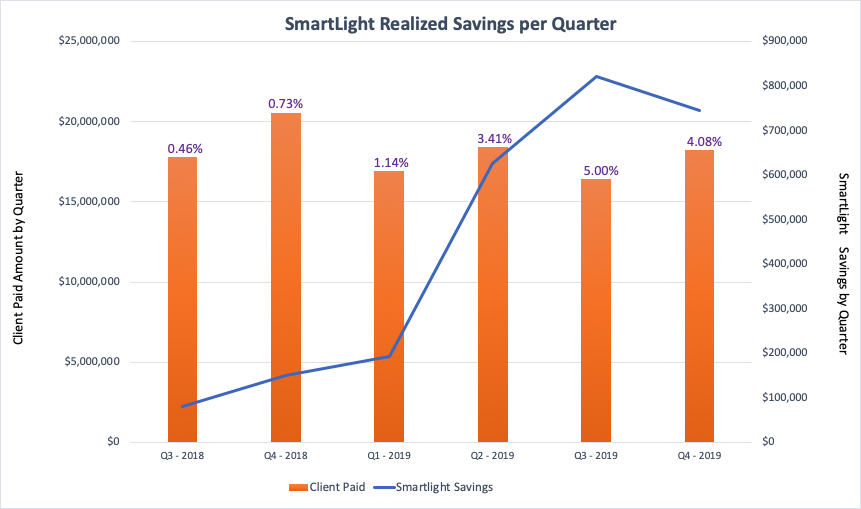A study released late last year estimated between $760 billion and $935 billion spent on healthcare in the U.S. is waste. That’s 25% of the total costs of healthcare according to estimates published on JAMA Network.1 Further broken down, the study found between $58.5 billion and $83.9 billion are a result of fraud and abuse, with another $76 billion plus wastefully spent on overtreatment or low-value care. With such staggering numbers, finding a way to reduce even a fraction of the fraud, waste and abuse could save employers millions each year.
As employers struggle to provide competitive benefits in the current economy where the jobless rate is low and healthcare costs continue to rise, turning inward to look at spending on healthcare is not only a recommended action, it is a fiduciary responsibility. It behooves a company to not only provide the highest quality benefits overall, but to make sure the money invested on health benefits is not wasted unnecessarily on issues like billing errors, abusive use of the emergency department, testing for medically unlikely scenarios, or on intentional fraud.
During the past two years, SmartLight Analytics has found patterns of such wasteful spending for employers across all industries. Examples of potential savings found for just three employers, each with more than 12,000 employees/family members covered under self-insured healthcare plans, ranged from $4 million to $8.9 million. The analytic healthcare data reviews showed some of the main sources of this waste includes:
- Fraud in the form of schemes like pass-through billing
- Waste on such things as hormone therapy misuse
- Overuse of emergency rooms
- “Waste in the US Health Care System: Estimated Costs and Potential for Savings,” William H. Sharnk, MD, MSHS; Teresa L. Rogstad, MPH, Natasha Parekh, MD, MS. October 7, 2019, JAMA Network
So how exactly is money being wasted on these things? Pass-through billing schemes, for example, can happen under the radar and go relatively unnoticed. In many cases, it involves doctors referring routine lab tests to rural hospitals, which are reimbursed at a higher rate, rather than sending them to local hospitals or labs. Doctors receive a kick-back and the rural hospital – which may often be struggling — is fed more business. In March 2019, the CEO of a Texas hospital pleaded guilty to a pass-through billing scheme involving more than $55 million in fraudulent claims. That is an extreme example, but more common examples exists in employer’s data regularly. One detailed clinical review of claims by analytic experts in 2019 found the exposure of pass-through billing for one employer to be more than $688,000 over two years.
Waste can be found in many forms in healthcare claims, but one form frequently identified is the misuse of testosterone therapy for male patients. A review of one employer’s healthcare claims data showed multiple provider groups fitting the suspect pattern of wasteful spending on testosterone replacement. Such a practice involves doctors treating patients for low testosterone levels, when in fact, the levels are not low enough for treatment. I can also take the form of excessive treatment and/or office visits for such unnecessary treatments. Regular analytical reviews by SmartLight Analytics found several providers were identified that appear to be supplementing their revenue by billing unnecessary office visit codes during every patient visit or providing unnecessary treatment. This extreme example was based on claims over a 30-month time period for approximately 500 members of a single employer. Exposure of billing of hormones was estimated to be more than $1.1 million for the employer.

Finally, ER overuse remains an issue when it comes to wasteful healthcare spending. Employers often find that a few “superusers” can drive up their healthcare costs excessively. However, identifying and working with those employees to find out why they are using the ER – whether it is for a chronic disease, addiction or lack of available primary care – can prove effective in eliminating this cost. One employer review identified a small number of superusers — 0.2% of the total number of covered employees for that employer – were spending $1.8 million on ER care. Taking action to identify and work with those employees could mean significant savings.
While the idea of eliminating fraud, waste and abuse is logical, most companies are not equipped to find where those issues are happening within their healthcare spend. Claims administrators focus their work on processing and paying claims, leaving the reviews left undone. Finding a third-party to work with claims administrators to regularly review claims can result in the identification of suspected patterns of waste or statistical outliers which can indicate abuse or fraud even. Such a collaboration will help companies take steps to remediate fraudulent claims or prevent further waste from happening.
Why Asha George started SmartLight Analytics
As an experienced healthcare analyst with an academic background in epidemiology and biostatistics, Asha George watched as healthcare costs continued to rise and knew the trend was unsustainable. She saw a focus on government overspending and waste in healthcare spending but did not see much attention being paid to the commercial side of healthcare.
“I had an insider perspective,” she said having spent 17 years working as an independent statistical consultant for multiple healthcare IT companies, directing Statistical Analytics teams, and developing and implementing predictive analytics products for large insurance carriers. She knew the numbers. “I had worked inside the industry and I knew that more and more companies were going toward the self-funded model for healthcare, yet they had little awareness of how their dollars were being spent.”
George knew there was waste, felt passionate about the need for transparency and saw a market for helping companies deal with this issue. She talked to experts in the field from physicians to data statisticians to healthcare lawyers about her idea. They all agreed there was an issue with fraud, waste and abuse and a void to be filled in the market. In fact, there were indisputable numbers backing up her concept of a need for attention in this space.
So, she went to work carving out a business plan and a business model working to focus her work on helping self-funded employers reduce their healthcare spending. She found a partner — a clinical expert who shared her passion about making a difference in this space of healthcare spending — in surgeon Dr. Franklin Baumann, who had also worked on the insurance side of healthcare. Together they knew there was real value in what they wanted to do with the unique solution SmartLight Analytics developed to help companies reduce healthcare costs.
The idea was quickly confirmed when the first employer they approached said yes to their solution in the first meeting. That was in 2016. They found their first big obstacle in getting access to the healthcare data they needed in order to analyze claims and identify areas for savings. It was an obstacle that seemed insurmountable at first. But with the help of a strong advocate in their first client, Dean Foods, they were able to obtain the data they needed to get to work. They used that roadmap for future clients and learned how to work effectively with the different parties involved.
“We learned quickly what didn’t work; we now look at ourselves as a partner with the insurance carriers,” George said. “We fill in the gap to provide the best service for our mutual employer clients.”
As a female in the healthcare IT industry, George knows she is a rarity and there are not many women at the tables she shares. Though she did have one meeting with a potential client where she was largely ignored and questions were directed to her male business partner only, which was unexpected – she said she does not think much about being a female role model or pioneer.
“I don’t think much about being a female entrepreneur, but a friend of mine who is a female entrepreneur was giving me the statistics that less than 2% of women-owned start-ups have revenue over $1 million and I was shocked.”
She chose to designate SmartLight Analytics as a “Certified Women’s Business Enterprise” specifically so she could represent the small number of women working in the healthcare IT field.
As for the future of SmartLight Analytics, George knows there are endless opportunities to serve self-funded businesses in reducing their healthcare spend. She is also positioning SmartLight to be a software solution company.
“Right now, we are providing a needed service, but we will ultimately be a software company.”
Published Feb. 25, 2020 for the Texas Healthcare Challenge blog
